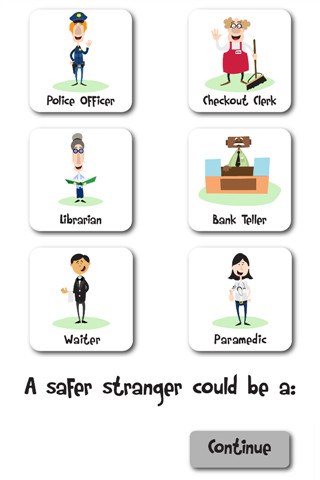Understanding “Safe Strangers” – A Guide for Parents
Hello, super parents! Are you looking for ways to keep your little ones secure and educated about the people around them? Well, buckle up, because you’re about to embark on a fabulous journey of empowering your children with the knowledge of “safe strangers”. It’s a topic that can seem a teeny bit scary at first, but by turning this learning experience into an adventure of awareness, you and your kiddos can navigate this important life lesson with confidence and ease.
Who are “Safe Strangers”?
Let’s start off with a burst of positivity! Not all strangers are bad news bears. In fact, many strangers can be superheroes in disguise, ready to lend a hand if your child is lost or in need of help. “Safe strangers” are individuals your child can turn to when they are in public places and feel threatened or scared. These can include police officers, firefighters, teachers, and even checkout clerks at the grocery store. We are going to learn all about identifying these safe individuals and what makes them friends rather than foes.
Navigating Stranger Safety with Your Child
Deep breath in, and out—preparing your children for the big wide world doesn’t have to be a stressful tsunami of nervousness. As a savvy parent, it’s all about building trust with your kids and helping them recognize that not every stranger is out to get them. Together, you’ll explore warning signs of potentially dangerous situations and discover the bright beacons of safe strangers.
- Talking to kids about strangers: Begin the dialogue about strangers with openness and honesty. Share stories and discuss different scenarios. “What if” games can be particularly insightful and fun!
- Identifying safe strangers: Identify people in uniforms or with name tags, and explain why they might be considered as trustworthy. Role playing can be a delightful way to practice!
- Safe places and landmarks: Brainstorm about safe places such as libraries, stores, or police stations. A scavenger hunt in your neighborhood could be an entertaining method to find these spots!
Creating a “Safe Stranger” Game Plan
Adventure time! Designing a game plan with your children can make them feel like the captains of their own safe ship. It’s all about teamwork—deciding on a family password, discussing when it’s okay to ask a stranger for help, and knowing personal information like full name, address, and a parent’s phone number. Let’s put those thinking caps on and map out a plan that gives them the compass they need to navigate safely.
When Safe Strangers are Not Around
What if your young explorer finds themselves on a deserted island with not a “safe stranger” in sight? No need to call in a rescue team just yet. Teach your children about alternative safety actions they can take, like finding a mother with children, retreating to a populated area, or using a loud voice to draw attention. Life rafts come in many forms, and it’s vital for kids to know all their options.
Lovely parents, the journey to understanding “safe strangers” starts with your guiding hand. With the groundwork laid in this guide, the seeds of safety are planted and ready to bloom in the minds of your little ones. Stay tuned for more wisdom on building trust, recognizing signs, and knowing that a heartwarming approach can turn a weighty topic into an enlightening quest for awareness and empowerment for your entire family. Because in the end, it’s not just about keeping your kids away from the baddies—it’s about arming them with the confidence and knowledge to find their way back to you, the ultimate safe harbor in any storm!
Get ready to continue this adventure with our next segment, where we’ll delve deeper into the strategies and tips that make learning about “safe strangers” more engaging and less intimidating for your children. Making sure they have all the right tools in their safety kit is our priority, so look forward to unlocking more valuable insights that affirm your role as a protector and educator—a truly unbeatable combination. Happy teachings!

5 Crucial Things Parents Should Know About Preparing Children for “Safe Strangers”
As parents, part of your superpower is equipping your children to face the world with smarts and a smile. When it comes to the concept of “safe strangers,” it’s essential to lay down a strong foundation. So, what are the fundamental things to remember as you embark on this important teaching journey? Here are five key teachings to set you on the right path:
1. The ‘Helping Hands’ Talk
Let’s talk strategy – specifically, the Helping Hands strategy. It’s all about recognizing those who are likely to help when children need assistance. Those clad in uniforms (like police officers, security guards, firefighters) are typically the safest bet. But don’t stop there, talk about non-uniformed ‘safe strangers’ such as store clerks and library staff who could also be of help. Role-playing who to approach can make this lesson especially sticky!
2. Safe Spaces and Happy Faces
Creating a mental map of friendly faces and safe spaces in your neighborhood can turn a nerve-racking conversation into an exhilarating discovery session. Point out safety zones like schools, police stations, libraries, and how to identify them. Bonus tip: inject some fun by playing “I Spy” with safe landmarks during your next family stroll.
3. The Crucial Contact Info
Info time! Every child’s mental toolkit should include their full name, home address, and a parent’s phone number. But here’s a spicy idea – make a catchy jingle out of it! Singing about personal details can be a memorable way for your child to retain important information. Plus, it’s a blast!
4. Emergency Planning
Strategize, don’t agonize! Blend preparation with imagination by creating contingency plans for different scenarios. Use storytelling to illustrate what your child should do if they get lost or need assistance. Encourage them to think of these plans as their personal adventures – with safe endings, of course!
5. The Confidence Crusade
Nothing beats knowledge-based confidence, and this is what your little ones will wear as their invisible, yet impenetrable, armor. Boost their self-assurance by showing trust in their decisions and reinforcing the idea that they have control over who they interact with. The goal is to grow a child who is not just alert but also assertive.
Remember, dear parents, that the true gem of this journey is the dialogue it sparks. Keep those lines of communication zesty and free-flowing. Doing so ensures that safety lessons aren’t just another box ticked, but a living, breathing part of your child’s daily life. And this is where the enchantment truly happens – when your kiddo can stride into the world, not just aware and alert, but also light-hearted and empowered. Because when it comes to your child’s safety, every day is an opportunity for learning… and every lesson an opportunity for laughter.
And, our journey doesn’t end here! Next, we’ll sail into understanding how these tips can be woven into the fabric of everyday life, making the concept of “safe strangers” second nature to your young ones. Good parenting isn’t just about guarding against the darkness, it’s about ushering in the light – one smart, happy step at a time!
See more great Things to Do with Kids in New Zealand here. For more information see here
Disclaimer
The articles available via our website provide general information only and we strongly urge readers to exercise caution and conduct their own thorough research and fact-checking. The information presented should not be taken as absolute truth, and, to the maximum extent permitted by law, we will not be held liable for any inaccuracies or errors in the content. It is essential for individuals to independently verify and validate the information before making any decisions or taking any actions based on the articles.




